Native Instruments M32 User Manual
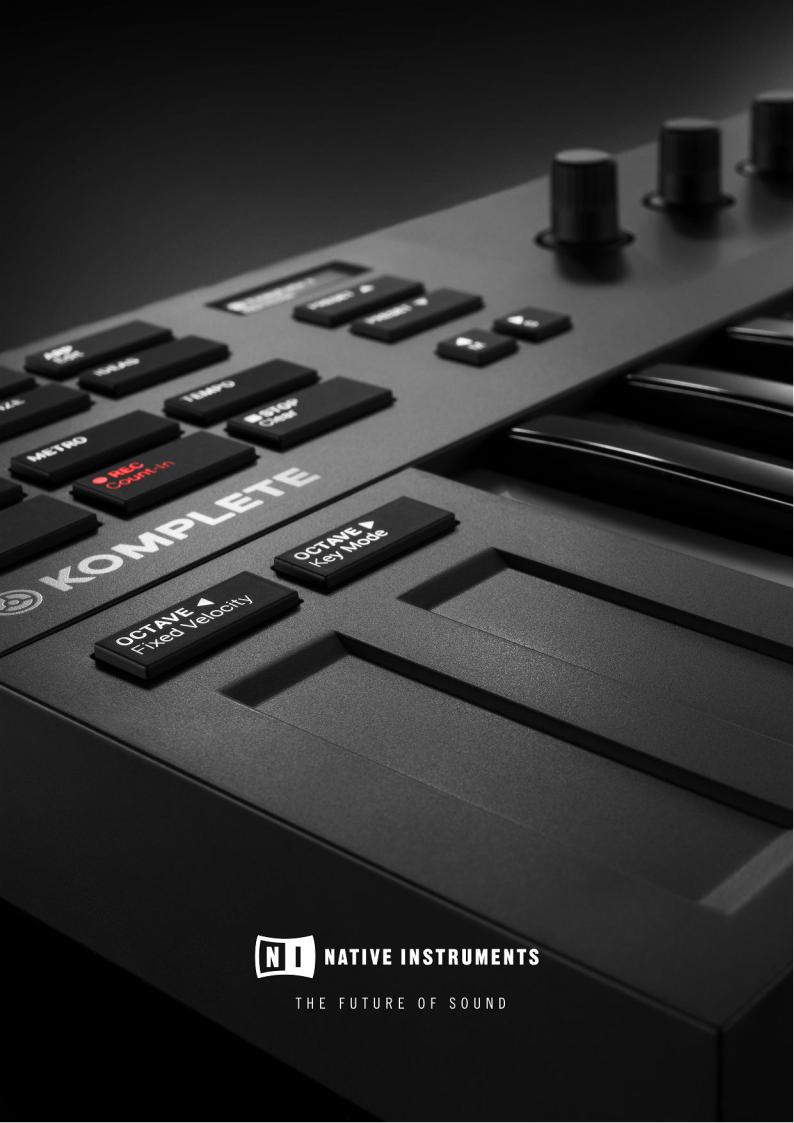

Table of Contents |
|
1. Disclaimer .................................................................................................................. |
1 |
2. Welcome to KOMPLETE KONTROL ............................................................................ |
2 |
2.1. Document Conventions ..................................................................................... |
2 |
2.2. Box Contents ................................................................................................... |
3 |
2.3. System Requirements ....................................................................................... |
3 |
2.4. Accessibility ..................................................................................................... |
3 |
2.4.1. Keyboard Overview ................................................................................ |
4 |
2.4.2. Activating Accessibility Features .............................................................. |
5 |
2.4.3. Training Mode ........................................................................................ |
6 |
2.4.4. Feature Overview and Keyboard Shortcuts .............................................. |
6 |
3. The KOMPLETE KONTROL Workflows ....................................................................... |
8 |
4. Setting up KOMPLETE KONTROL ............................................................................ |
10 |
4.1. Connecting the Keyboard to the Computer ....................................................... |
10 |
4.2. Setting up the Stand-Alone Application ............................................................. |
11 |
4.3. Setting up Host Integration .............................................................................. |
12 |
4.3.1. Setting up Apple Logic Pro X and GarageBand ...................................... |
12 |
4.3.2. Setting up Ableton Live ......................................................................... |
13 |
4.4. Connecting a Sustain Pedal to the Keyboard .................................................... |
13 |
5. Software Overview .................................................................................................... |
14 |
5.1. Header .......................................................................................................... |
14 |
5.2. Browser ......................................................................................................... |
15 |
5.2.1. Library Pane ........................................................................................ |
16 |
5.2.2. Product Selector ................................................................................... |
17 |
5.2.3. Files Pane ............................................................................................ |
18 |
5.3. Perform Panel ................................................................................................ |
20 |
5.4. Plug-in Panel .................................................................................................. |
20 |
5.5. Plug-in Chain Panel ........................................................................................ |
20 |
5.6. Plug-in Area ................................................................................................... |
21 |
5.7. Sampler ......................................................................................................... |
22 |
5.7.1. Envelopes ............................................................................................ |
23 |
6. Keyboard Overview .................................................................................................. |
25 |
6.1. Perform and Edit Section ................................................................................ |
26 |
6.2. Transport Section ........................................................................................... |
27 |
6.3. Navigation and Mode Buttons .......................................................................... |
27 |
6.4. Transpose Buttons .......................................................................................... |
28 |
7. Global Controls and Preferences ............................................................................... |
30 |
7.1. Instrument Views ............................................................................................ |
30 |
7.1.1. Default View ......................................................................................... |
31 |
7.1.2. Additional View ..................................................................................... |
31 |
7.1.3. Edit View ............................................................................................. |
32 |

7.2. Switching Instances ........................................................................................ |
33 |
7.3. Transport and Tempo ...................................................................................... |
33 |
7.3.1. Resetting the Clock .............................................................................. |
34 |
7.3.2. Adjusting Tempo ................................................................................... |
35 |
7.4. Adjusting Master Volume ................................................................................. |
35 |
7.5. Preferences ................................................................................................... |
36 |
7.5.1. Preferences – Audio Page .................................................................... |
36 |
7.5.2. Preferences – MIDI Page ...................................................................... |
37 |
7.5.3. Preferences – General Page ................................................................. |
38 |
7.5.4. Preferences – Library Page ................................................................... |
39 |
7.5.5. Preferences – Plug-ins Page ................................................................. |
42 |
7.6. Loading a Plug-in in Default State .................................................................... |
44 |
8. Browsing the Library ................................................................................................. |
46 |
8.1. Browser Basics .............................................................................................. |
46 |
8.1.1. Product Types: Instruments, Loops, One-shots and Effects ..................... |
46 |
8.1.2. Loops and One-shots ........................................................................... |
47 |
8.1.3. About the Library and Meta-Information ................................................. |
47 |
8.1.4. Browsing the Library vs. Browsing Your Hard Disks ................................ |
47 |
8.2. Opening the Browser ...................................................................................... |
48 |
8.3. Loading Preset Files ....................................................................................... |
49 |
8.4. Choosing Between Factory Content and User Content ...................................... |
49 |
8.5. Filtering Preset Files by Product ...................................................................... |
50 |
8.6. Filtering Preset Files by Bank .......................................................................... |
52 |
8.7. Resetting the Product Selection ....................................................................... |
53 |
8.8. Types and Characters Tags ............................................................................. |
54 |
8.8.1. Filtering Preset Files by Types and Characters ....................................... |
56 |
8.8.2. Selecting Multiple Tags from the Same Level .......................................... |
57 |
8.9. Working with Favorites .................................................................................... |
58 |
8.9.1. Adding Preset Files to the Favorites ....................................................... |
58 |
8.9.2. Displaying Favorites in the Results List .................................................. |
59 |
8.9.3. Removing Preset Files from the Favorites .............................................. |
60 |
8.10. Performing a Text Search .............................................................................. |
61 |
8.11. Displaying Preset File Information .................................................................. |
61 |
8.12. Auditioning your Preset Files ......................................................................... |
61 |
9. Working with Effects ................................................................................................. |
63 |
9.1. Opening the Plug-in Chain Panel ..................................................................... |
63 |
9.2. Adding Effects ................................................................................................ |
63 |
9.3. Selecting Plug-in Slots .................................................................................... |
65 |
9.4. Reordering Effects .......................................................................................... |
65 |
9.5. Scrolling the Plug-in Chain .............................................................................. |
66 |
9.6. Bypassing Effects ........................................................................................... |
67 |
9.7. Removing Effects ........................................................................................... |
67 |
10. Managing the Library .............................................................................................. |
69 |
10.1. Saving Preset Files to the User Library ........................................................... |
69 |
10.2. Deleting User Preset Files from the User Library ............................................. |
71 |

10.3. Editing the Tags and Properties of User Preset Files ....................................... |
71 |
10.4. Syncing Multiple Instances ............................................................................ |
74 |
10.5. Working with the Files Pane .......................................................................... |
75 |
10.5.1. Additional Results List Features List in the Files Pane ........................... |
75 |
10.5.2. Navigating to File Locations with the Location Bar ................................ |
76 |
10.5.3. Navigating to Recent File Locations ..................................................... |
76 |
10.5.4. Working with File Location Favorites .................................................... |
76 |
10.6. Loading VST Plug-ins ................................................................................... |
77 |
10.7. Installing NKS Instruments ............................................................................ |
78 |
10.8. Importing KOMPLETE KONTROL-Compatible User Files ................................ |
80 |
11. Controlling Instrument, Loop, One-shot and Effect Parameters .................................. |
82 |
11.1. About Pre-Mapped Instruments, Loops, One-shots and Effects ........................ |
82 |
11.2. Adjusting Parameters .................................................................................... |
82 |
11.3. Switching Parameter Pages ........................................................................... |
82 |
11.4. Customizing Parameter Mappings using the Plug-in Panel .............................. |
83 |
12. Smart Play – Playing and Editing Scales and Chords ................................................ |
85 |
12.1. A Note about Music Theory ........................................................................... |
85 |
12.2. Activating the Scale Engine ........................................................................... |
86 |
12.3. Selecting and Playing a Scale ....................................................................... |
87 |
12.4. Playing Chords ............................................................................................. |
87 |
12.5. Editing Scales and Chords ............................................................................ |
88 |
12.6. Setting the SCALE Parameters ...................................................................... |
88 |
12.6.1. SCALE Root Note ............................................................................... |
89 |
12.6.2. SCALE Bank and Type ....................................................................... |
89 |
12.7. Setting the KEY MODE Parameter ................................................................. |
93 |
12.8. Setting the CHORD Parameters .................................................................... |
94 |
12.8.1. CHORD Mode .................................................................................... |
94 |
12.8.2. CHORD Type ..................................................................................... |
95 |
12.8.3. CHORD Position ................................................................................ |
97 |
13. Smart Play – Playing and Editing Arpeggiator Sequences ......................................... |
99 |
13.1. Playing Arpeggiator Sequences ..................................................................... |
99 |
13.2. Editing the Arpeggiator ................................................................................. |
100 |
13.3. MAIN Parameters ........................................................................................ |
101 |
13.3.1. MAIN Mode ....................................................................................... |
101 |
13.3.2. MAIN Type ........................................................................................ |
101 |
13.4. RHYTHM Parameters .................................................................................. |
102 |
13.4.1. RHYTHM Rate .................................................................................. |
102 |
13.4.2. RHYTHM Sequence .......................................................................... |
103 |
13.4.3. RHYTHM Swing ................................................................................ |
103 |
13.5. OTHER Parameters ..................................................................................... |
104 |
13.5.1. OTHER Octaves ................................................................................ |
104 |
13.5.2. OTHER Dynamic ............................................................................... |
104 |
13.5.3. OTHER Gate ..................................................................................... |
105 |
13.6. ADVANCED Parameters .............................................................................. |
105 |
13.6.1. ADVANCED Retrigger ........................................................................ |
105 |

13.6.2. ADVANCED Repeat ........................................................................... |
106 |
13.6.3. ADVANCED Offset ............................................................................ |
106 |
13.6.4. ADVANCED Inversion ........................................................................ |
106 |
13.7. RANGE Parameters ..................................................................................... |
106 |
13.7.1. RANGE Min. Key ............................................................................... |
107 |
13.7.2. RANGE Max. Key .............................................................................. |
107 |
13.8. HOLD Parameter ......................................................................................... |
107 |
14. MIDI Communication .............................................................................................. |
109 |
14.1. Mapping MIDI Controls to Third-Party Controllers .......................................... |
109 |
14.2. Host Automation .......................................................................................... |
111 |
14.2.1. Recording Automation ....................................................................... |
111 |
14.2.2. Automation IDs for the Perform Panel ................................................. |
111 |
15. Host Integration ..................................................................................................... |
113 |
15.1. Integration with MASCHINE ......................................................................... |
113 |
15.1.1. Basic Control Functions ..................................................................... |
114 |
15.1.2. Advanced Integration Control Functions .............................................. |
114 |
15.2. Integration with Ableton Live ......................................................................... |
115 |
15.3. Integration with Apple Logic Pro X and GarageBand ...................................... |
117 |

Disclaimer
1. DISCLAIMER
The information in this document is subject to change without notice and does not represent a commitment on the part of Native Instruments GmbH. The software described by this document is subject to a License Agreement and may not be copied to other media. No part of this publication may be copied, reproduced or otherwise transmitted or recorded, for any purpose, without prior written permission by Native Instruments GmbH, hereinafter referred to as Native Instruments.
“Native Instruments”, “NI” and associated logos are (registered) trademarks of Native Instruments GmbH.
Mac, macOS, GarageBand, Logic and iTunes are registered trademarks of Apple Inc., registered in the U.S. and other countries.
Windows and DirectSound are registered trademarks of Microsoft Corporation in the United States and/or other countries.
Ableton Live™ and LINK™ are a trademarks of Ableton AG.
ASIO and VST are a trademark and software of Steinberg Media Technologies GmbH.
All other trademarks are the property of their respective owners and use of them does not imply any affiliation with or endorsement by them.
Document authored by: Native Instruments GmbH
Software version: 2.1 (02/2019)
Hardware version: KOMPLETE KONTROL M32
Special thanks to the Beta Test Team, who were invaluable not just in tracking down bugs, but in making this a better product.
1
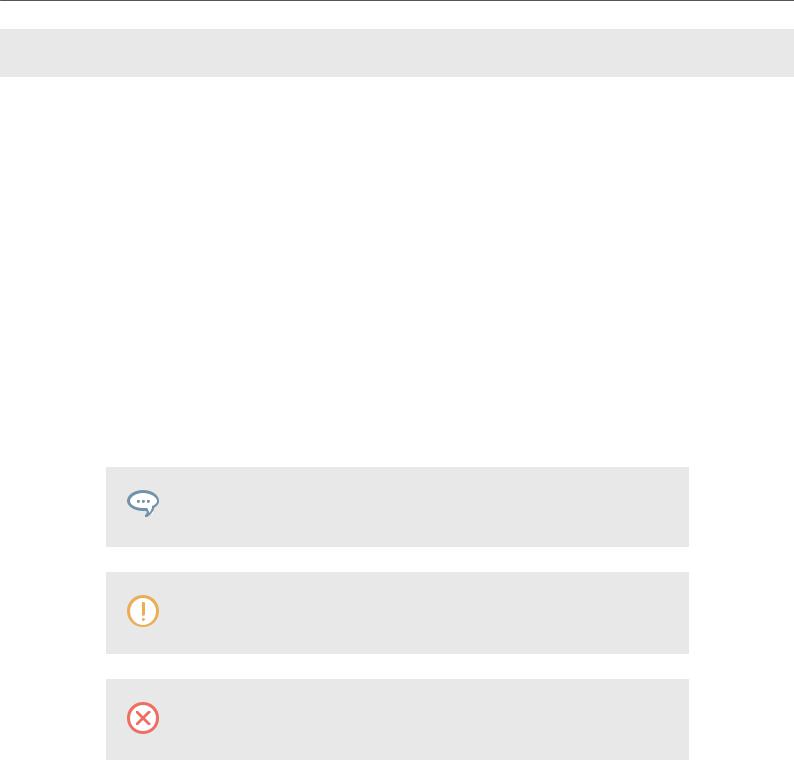
Welcome to KOMPLETE KONTROL
2. WELCOME TO KOMPLETE KONTROL
Thank you for choosing KOMPLETE KONTROL!
The KOMPLETE KONTROL software and its dedicated keyboard—the KOMPLETE KONTROL M32—form a tightly integrated music production and performance system that brings all the sounds from KOMPLETE and the Native Kontrol Standard (NKS) to the heart of your workflow.
KOMPLETE KONTROL offers advanced integration with a number of hosts and provides full control of any Instruments supporting NKS, both from Native Instruments and partners. The keyboard lets you browse your Instruments, Loops, One-Shots and Effects in an intuitive way and play them creatively with KOMPLETE KONTROL’s unique Scale engine and Arpeggiator.
We hope you enjoy this fantastic instrument as much as we do.
—The team at Native Instruments
2.1. Document Conventions
This document uses particular formatting to point out special facts and to warn you of potential issues. The icons introducing the following notes let you see what kind of information can be expected:
The speech bubble icon indicates a useful tip that may often help you to solve a task more efficiently.
The exclamation mark icon highlights important information that is essential for the given context.
The red cross icon warns you of serious issues and potential risks that require your full attention.
Furthermore, the following formatting is used:
•Text appearing in (drop-down) menus (such as Open…, Save as… etc.) in the software and paths to locations on your hard disk or other storage devices is printed in italics.
•Text appearing elsewhere (labels of buttons, controls, text next to checkboxes etc.) in the software is printed in blue. Whenever you see this formatting applied, you will find the same text appearing somewhere on the screen.
•Text appearing on the displays of the controller is printed in light grey. Whenever you see this formatting applied, you will find the same text on a controller display.
2

Welcome to KOMPLETE KONTROL
•Text appearing on labels of the hardware controller is printed in orange. Whenever you see this formatting applied, you will find the same text on the controller.
•Important names and concepts are printed in bold.
•References to keys on your computer’s keyboard you’ll find put in square brackets (e.g., “Press [Shift] + [Enter]”).
•Single instructions are introduced by this play button type arrow. Results of actions are introduced by this smaller arrow.
Naming Convention
Throughout the documentation we will refer to KOMPLETE KONTROL keyboard (or just keyboard) as the hardware controller and KOMPLETE KONTROL software as the software installed on your computer.
2.2. Box Contents
The box contains the following items:
•KOMPLETE KONTROL keyboard
•USB cable
•Information flyer providing:
•the hardware serial number of the KOMPLETE KONTROL keyboard
•a web link for downloading the KOMPLETE KONTROL software and the KOMPLETE SE-
LECT software bundle
•Safety Instructions flyer
2.3. System Requirements
For KOMPLETE KONTROL to fully function as indented, your system needs to meet certain requirements. The latest KOMPLETE KONTROL system requirements and compatibility information is available here:
https://www.native-instruments.com//komplete-kontrol-m32/specifications/
KOMPLETE
KOMPLETE KONTROL is optimized for use with KOMPLETE SELECT, KOMPLETE and KOMPLETE ULTIMATE.
The latest KOMPLETE system requirements and compatibility information is available here:
http://www.native-instruments.com/products/komplete/
2.4. Accessibility
KOMPLETE KONTROL offers a set of accessibility features for visually-impaired users. These are focused exclusively on the KOMPLETE KONTROL keyboard itself and include speech output via your computer for the following features:
3

Welcome to KOMPLETE KONTROL
•Perform, Transpose, Page left / right, and key navigation buttons.
•All Browser functions.
•The current edit mode, including the Plug-in Panel and the Perform panel (Scale, Arp).
•Names of parameters and parameter sections when touching knobs, including all edit modes.
The accessibility features are particularly useful when combined with KOMPLETE KONTROL’s host integration and Apple VoiceOver in Apple Logic Pro X and GarageBand.
2.4.1. Keyboard Overview
The buttons and knobs on the KOMPLETE KONTROL keyboard are organized in the following groups:
•Perform and Edit section
•Transport section
•Solo and Mute buttons
•Preset and Page buttons
•Control section
•Navigation and Mode buttons
•4-Directional Push Encoder (referred to as the 4-D encoder)
•Transpose and Fixed Velocity buttons
The Perform and Edit section is located at the top left of the keyboard. It contains six buttons that are arranged in two rows.
The buttons in the first row are (from left to right):
•SHIFT
•SCALE (Edit)
•ARP (Edit)
The buttons in the second row are (from left to right):
•UNDO (Redo)
•QUANTIZE
•AUTO
The Transport section is located directly below the Perform and Edit section. It contains six buttons that are arranged in two rows.
The buttons in the first row are (from left to right):
•LOOP
•METRO
4

Welcome to KOMPLETE KONTROL
• TEMPO
The buttons in the second row are (from left to right):
•PLAY (Restart)
•REC (Count-In)
•STOP
The Solo and Mute buttons are located to the right of the Transport section. The two buttons are arranged in a row.
The buttons are (from left to right):
•Mute
•Solo
The Preset buttons are located to the bottom right of the Perform and Edit section, above the Solo and Mute buttons. The four buttons are arranged in a column.
The buttons are (from top to bottom):
•PRESET Up
•PRESET Down
The Control section is located in the center of the KOMPLETE KONTROL keyboard. It contains eight knobs. The knobs are arranged in a row directly above the keybed.
The Navigation buttons are on the top right of the KOMPLETE KONTROL keyboard. The three buttons are arranged in one row, (from left to right):
•BROWSER
•PLUG-IN
•TRACK
The 4-D encoder is located directly below the Navigation buttons.
The Transpose buttons are located at the far left of the keyboard next to the keybed and directly above the Pitch and Modulation Touch Strips. The two buttons are arranged in a row.
The buttons are (from left to right):
•OCT Down / FIXED VEL (TS Mode)
•OCT Up
2.4.2. Activating Accessibility Features
In order to activate or deactivate the accessibility features from the KOMPLETE KONTROL keyboard while the KOMPLETE KONTROL software is running:
1.Press and hold the SHIFT button on the top left of the keyboard.
2.While holding SHIFT, press the IDEAS button, located third to the right, in the second row on the keyboard.
5
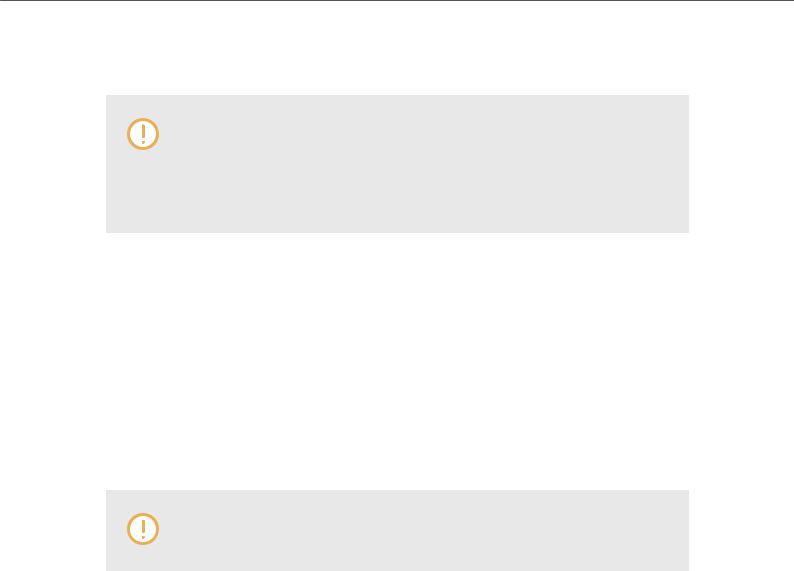
Welcome to KOMPLETE KONTROL
The speech output confirms that the accessibility features have been activated or deactivated.
The accessibility features are designed to be used with the KOMPLETE KONTROL plug-in. However, the KOMPLETE KONTROL stand-alone application must be opened after initial installation and after installing additional Instruments and Effects. This will ensure that all Instruments, Loops, One-shots and Effects are displayed correctly in the KOMPLETE KONTROL Browser.
2.4.3. Training Mode
KOMPLETE KONTROL Training Mode makes it easy to locate a specific button or parameter without accidentally triggering an action. When Training Mode is activated, all button presses and parameter names are announced but the corresponding action is not triggered.
Activating Training Mode
•To activate or deactivate Training Mode from the KOMPLETE KONTROL keyboard while the KOMPLETE KONTROL software is running, double-press the SHIFT button on the top left of the keyboard.
Training Mode is only available when the accessibility features have been activated.
2.4.4. Feature Overview and Keyboard Shortcuts
The following overview outlines the availability of accessibility features for different aspects of KOMPLETE KONTROL from both the KOMPLETE KONTROL keyboard and the KOMPLETE KONTROL software. In the table you also can find the relevant keyboard shortcut.
|
Feature |
Accessi- |
Keyboard Shortcut |
|
|
ble from |
|
|
|
Keyboard |
|
Accessibility |
Enable or disable Accessibility mode |
Yes |
SHIFT + IDEAS |
Mode |
|
|
|
|
|
|
|
|
Enable or disable speech output for names of Preset |
|
SHIFT + Button 5 |
|
files |
|
|
Browser |
Browse for Factory and User Preset files |
Yes |
Page left button or Page |
|
|
|
right button |
|
|
|
|
|
Switch between Category and Vendor sorting |
Yes |
SHIFT + Knob 1 |
|
Set Preset file Favorites |
Yes |
SHIFT + Knob 4 |
|
|
|
|
|
Sort by Favorites |
|
SHIFT + Knob 3 |
|
Save and edit User Preset files |
No |
|
|
|
|
|
|
Browse for NKS plug-ins from other vendors |
Yes |
Supported by default |
|
|
|
|
6
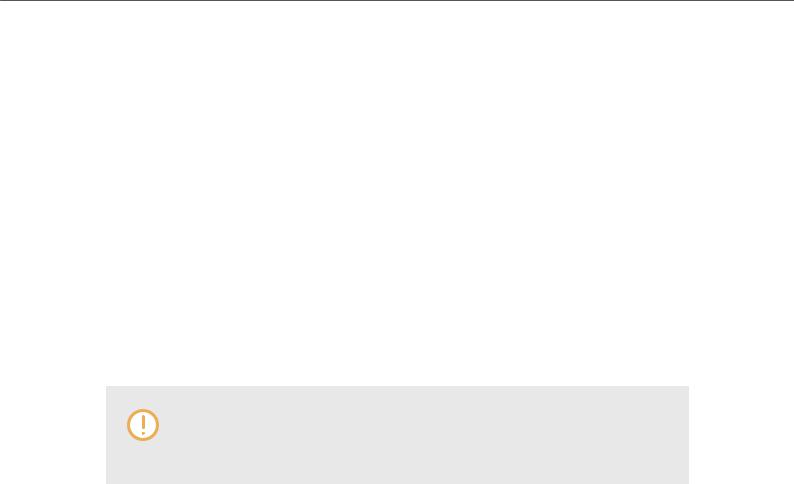
Welcome to KOMPLETE KONTROL
|
Feature |
Accessi- |
Keyboard Shortcut |
|
|
ble from |
|
|
|
Keyboard |
|
Instrument |
Adjust key Instrument parameters |
Yes |
Knob 1 – 8 |
control |
|
|
|
|
|
|
|
|
Custom map Instrument parameters |
No |
|
Smart Play |
Accessing Scale and Chord Parameters |
Yes |
SHIFT + SCALE Edit |
|
|
|
|
|
Adjust Scale & Chord parameters |
|
Knob 1 – 8 |
|
Accessing Arp Parameters |
Yes |
SHIFT + ARP Edit |
|
|
|
|
|
Adjust Arp parameters |
|
Knob 1 – 8 |
|
Selecting Parameter Pages |
|
Page left or Page right |
|
|
|
|
Tempo |
Adjust BPM |
Yes |
TEMPO + Knob 1 |
Training |
Find a control without accidentally triggering actions |
Yes |
|
mode |
|
|
|
|
|
|
|
|
Enabling or disabling Training mode |
Yes |
Double-press SHIFT |
Preferences |
Adjust software & hardware preferences |
No |
|
|
|
|
|
Software di- |
Be notified if a dialog box opens in the software (dialog |
Yes |
Supported by default |
alog |
content is not available for speech output) |
|
|
|
|
|
|
Accessibility for KOMPLETE KONTROL’s host integration is only available when using Apple VoiceOver in Logic Pro X and GarageBand. For more information about KOMPLETE KONTROL’s host integration features, refer to Host Integration.
7

The KOMPLETE KONTROL Workflows
3. THE KOMPLETE KONTROL WORKFLOWS
KOMPLETE KONTROL brings all the sounds from KOMPLETE and the Native Kontrol Standard (NKS) to the center of your workflows, the stand-alone workflow and the host integration workflow.
Stand-alone Workflow
When using KOMPLETE KONTROL in stand-alone mode, the workflow is the following:
1.Find Preset files you like from any of the Instruments, Loops, One-Shots and Effects by browsing with the keyboard, supported by the Browser’s filters.
2.Use the keyboard’s Control section to adjust the loaded Instrument and Effect(s) and create your own unique sound.
3.Optionally, you can enable KOMPLETE KONTROL’s Smart Play features to enrich your playing with the Scale engine and the Arpeggiator.
Host Integration Workflow
KOMPLETE KONTROL’s advanced integration in a number of hosts enables you to quickly capture ideas, with immediate access to the sounds you need, all directly from the KOMPLETE KONTROL keyboard.
The KOMPLETE KONTROL host integration workflow is streamlined to remove any obstacles when sketching out a new song in a supported host:
1.Select a track that hosts the KOMPLETE KONTROL plug-in with the navigation controls on the keyboard. This is made possible by KOMPLETE KONTROL’s advanced host integration.
2.Find Preset files you like from any of the Instruments and Effects in your KOMPLETE KONTROL Library by browsing with the keyboard, supported by the Browser’s filters.
3.Use the keyboard’s Control section to adjust the loaded Instrument and Effect(s) and create your own unique sound.
4.Optionally, you can enable KOMPLETE KONTROL’s Smart Play features to enrich your playing with the Scale engine and the Arpeggiator.
5.Record a new clip in the host, conveniently controlling transport and loop functions directly from the keyboard. Again, made possible by KOMPLETE KONTROL’s advanced host integration.
6.If you need to start over, undo and redo functions are right at your fingertips. To further refine your recording, you can apply quantization and automation to a clip by pressing the corresponding buttons on the keyboard.
You have quickly captured a musical idea and can continue sketching out a new song by repeating the process and layering more tracks.
Key Features
The following key features facilitate the KOMPLETE KONTROL workflow:
•Browser: The Browser is your interface for finding, loading and organizing Instruments, Loops, One-Shots, Effects, and Preset files from the KOMPLETE KONTROL Library. For more information, refer to Browsing the Library, Working with Effects and Managing the Library.
8

The KOMPLETE KONTROL Workflows
•Instrument and Effect control: The knobs and Touch Strips on the keyboard are pre-mapped to all KOMPLETE and NKS Instruments, Loops, One-shots and Effects for immediate control. For more information, refer to Controlling Instrument, Loop, One-shot and Effect Parameters.
•Smart Play: The Scale engine and the Arpeggiator let you play and generate scales, chords, and arpeggiator sequences. For more information, refer to Smart Play – Playing and Editing Scales and Chords and Smart Play – Playing and Editing Arpeggiator Sequences.
•Host integration: Advanced integration in a number of hosts allows you control core functionality directly from the keyboard. For more information, refer to Setting up Host Integration and Host Integration.
9
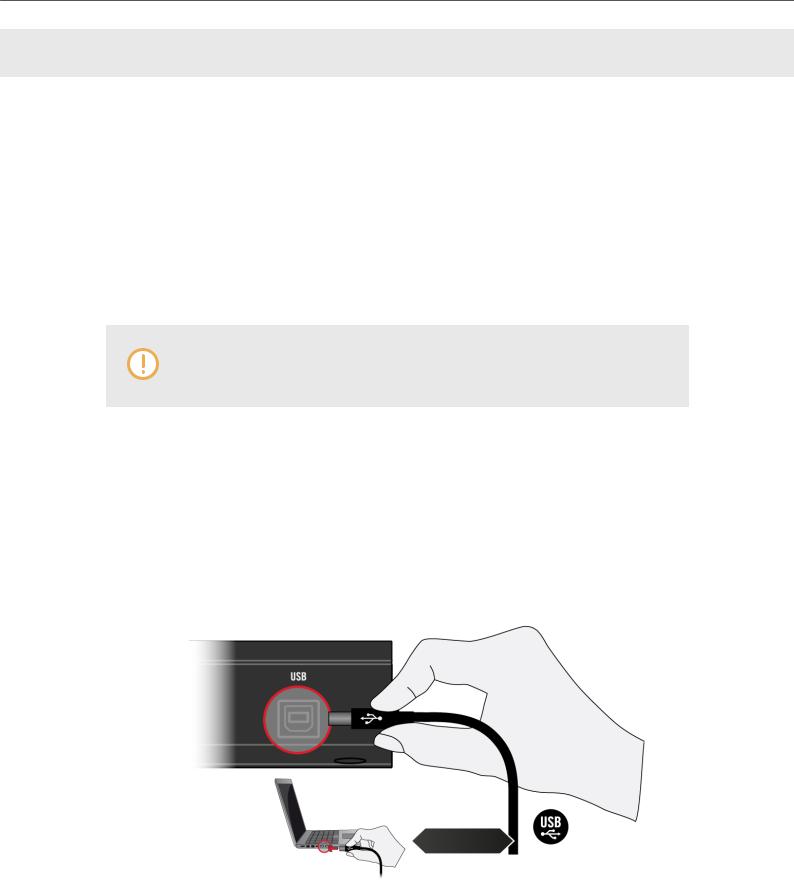
Setting up KOMPLETE KONTROL
4. SETTING UP KOMPLETE KONTROL
This section provides basic setup information for using the KOMPLETE KONTROL stand-alone software, and guides you through the process of integrating KOMPLETE KONTROL in supported hosts.
The KOMPLETE KONTROL software is installed both as a stand-alone application as well as a VST, Audio Unit, and AAX plug-in.
The KOMPLETE KONTROL stand-alone application directly communicates with your audio and MIDI interfaces, which you can configure in the KOMPLETE KONTROL Preferences. When KOMPLETE KONTROL is used as a plug-in within a host, the communication with your audio and MIDI interfaces is managed by the host.
For details about the audio and MIDI configuration of the host, and how to load plugins, please refer to its documentation.
4.1. Connecting the Keyboard to the Computer
To connect the KOMPLETE KONTROL keyboard to your computer:
1.Attach the device end of the included USB cable to the USB socket on the rear panel of the keyboard.
2.Attach the computer end of the USB cable to an available USB 2.0 (or later) port on your computer.
3.Press the power switch on the rear panel of the keyboard to switch it on. The keyboard is now detected by the operating system.
10
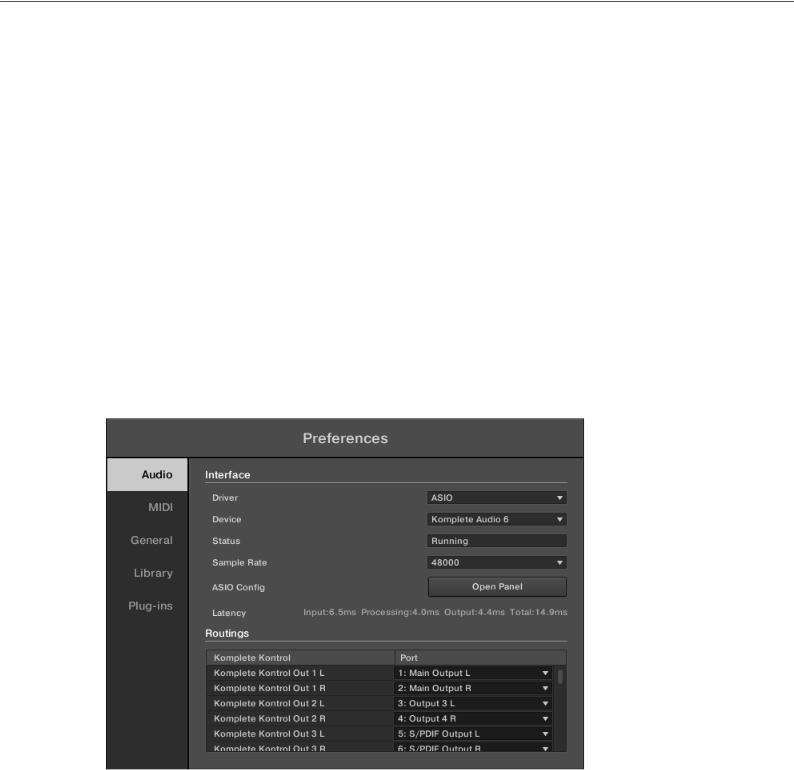
Setting up KOMPLETE KONTROL
4.2. Setting up the Stand-Alone Application
When you launch the KOMPLETE KONTROL software from its installation directory, it starts as a stand-alone application independently from a host.
By default, the application uses the standard audio interface of your computer. In order to use another audio interface, and receive MIDI notes from the keyboard, you need to configure the application in the Preferences.
Configuring Audio Interface
1.In the KOMPLETE KONTROL menu click on Edit > Preferences to open the Preferences.
2.Click on Audio to display the Audio page.
3.Select the hardware driver supported by your audio interface from the Driver drop-down menu.
4.Select the audio interface from the Device drop-down menu.
5.Under Routings, select the left and right output channels of your audio interface you want to use for KOMPLETE KONTROL’s master output in the Komplete Kontrol Out 1 L and Komplete Kontrol Out 1 R drop-down menus.
Preferences panel — Audio page.
Enabling MIDI Control
1.Click on MIDI to display the MIDI page.
2.Click on Input to display the available devices for incoming MIDI signals.
3.Click the checkbox representing your keyboard, for example, Komplete Kontrol M32 MIDI to activate incoming MIDI signals from the keyboard.
11
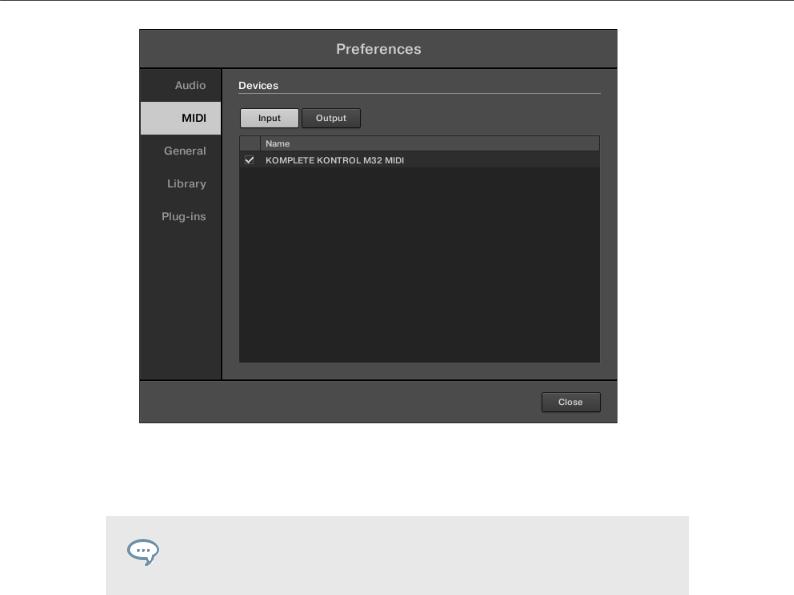
Setting up KOMPLETE KONTROL
Preferences panel — MIDI page (entries may vary on your computer).
The software is configured and ready to be controlled with the keyboard.
The MIDI Output settings are required for using KOMPLETE KONTROL’s Smart Play features with other MIDI instruments.
4.3. Setting up Host Integration
KOMPLETE KONTROL integrates with a number of hosts to facilitate a fluent workflow for performing and recording music with your KOMPLETE KONTROL Library.
Before using the KOMPLETE KONTROL keyboard to control a supported host, a few configuration steps are required:
4.3.1. Setting up Apple Logic Pro X and GarageBand
Apple Logic Pro X and GarageBand are automatically configured for advanced integration with KOMPLETE KONTROL once you launch the respective application for the first time after installing the KOMPLETE KONTROL software. Ensure that the keyboard is connected and switched on before launching the application.
A dialog asks you to confirm this after launching the application:
For a detailed overview of Integration controls for Logic Pro X / GarageBand refer to Integration with Apple Logic Pro X and GarageBand.
12
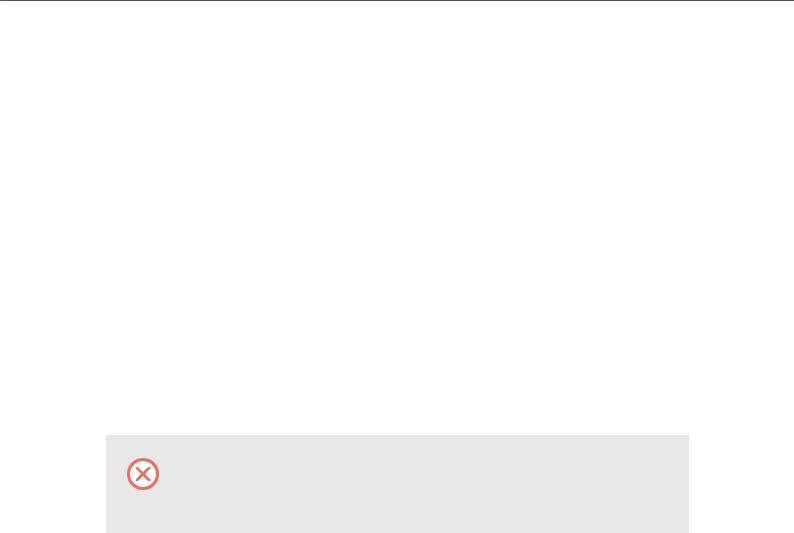
Setting up KOMPLETE KONTROL
4.3.2. Setting up Ableton Live
Ableton Live must be configured for advanced integration with KOMPLETE KONTROL.
Configuring Ableton Live for KOMPLETE KONTROL
Once the MIDI Remote Script and the Instrument Rack file are installed in the correct location, you need to add KOMPLETE KONTROL as a control surface in Ableton Live's preferences:
1.Launch Ableton Live.
2.In Ableton Live, go to the Preferences and open the Link / MIDI tab.
3.In a free control surface slot select KOMPLETE KONTROL A from the Control Surface drop-down menu.
4.For the control surface input select KOMPLETE KONTROL A DAW in the Input drop-down menu.
5.For the control surface output select KOMPLETE KONTROL A DAW in the Output dropdown menu.
Loading KOMPLETE KONTROL in Ableton Live
The KOMPLETE KONTROL stand-alone application must be opened once before using the plug-in within your DAW for the first time, and after installing new Instruments and Effects.
To load KOMPLETE KONTROL:
1.Ensure that the keyboard is connected to your computer.
2.In Ableton Live, select the Plug-ins folder in the Browser to display the installed plug-ins.
3.Drag the KOMPLETE KONTROL entry from the Browser list to an empty MIDI track. You are now ready to use KOMPLETE KONTROL within Ableton Live.
For a detailed overview of Integration controls for Ableton Live refer to Integration with Ableton Live.
4.4. Connecting a Sustain Pedal to the Keyboard
The keyboard provides you with a pedal input on its rear panel: FOOT PEDAL. This input allows you to connect a sustain pedal or footswitch to control sustain of the notes you play.
To connect the sustain pedal to the keyboard:
•Connect the sustain pedal to the FOOT PEDAL input at the rear panel of the keyboard.
13
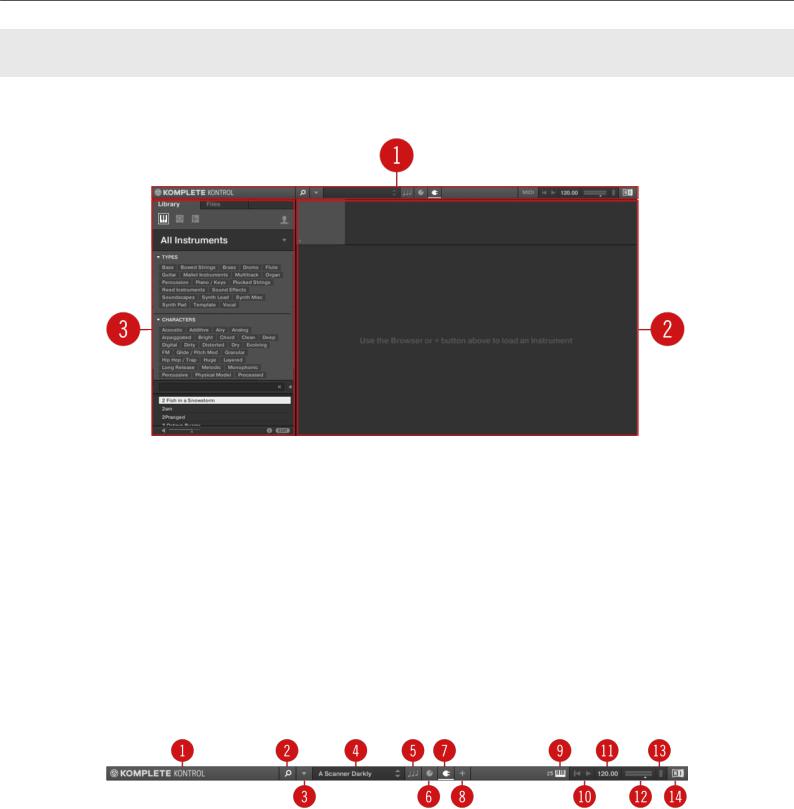
Software Overview
5. SOFTWARE OVERVIEW
This section gives an overview of the areas and controls of the KOMPLETE KONTROL software.
Overview of the KOMPLETE KONTROL software.
(1) Header: Provides access to general functions like the Main menu, the Preset display, the Transport and Master Volume controls, as well as options to show and hide user interface areas. For more information, refer to Header.
(2) Plug-in area: Shows your loaded Instrument, Loop, One-shot or Effect and enables you control it directly in the software. For more information, refer to Plug-in Area.
(3) Browser: Provides access to your Instruments, Loops, One-shots and Effects. It also enables you to add, edit, and manage your Preset files. For more information, refer to Browser.
5.1. Header
The header is where you find general settings that affect KOMPLETE KONTROL globally. It also lets you access additional user interface areas.
The header.
(1) KOMPLETE KONTROL logo: Opens the About screen, which shows the version number of the KOMPLETE KONTROL software.
(2) Browser button: Shows or hides the Browser. For more information, refer to Browser.
(3) KOMPLETE KONTROL menu: Opens the KOMPLETE KONTROL menu, which contains a number of general functions and settings, including the Preferences.
14

Software Overview
(4) Preset display: Displays the name of the loaded Preset file or KONTAKT key switch. The arrow buttons on the right skip to the next Preset file in the Browser’s Results list.
(5) Perform panelbutton: Shows or hides the Perform panel, which gives you access to the parameters of the Scale engine and the Arpeggiator. The Perform panel button lights up blue when the Scale engine and/or the Arpeggiator are enabled. For more information, refer to Perform Panel.
(6) Plug-in panel button: Shows or hides the Plug-in panel, which allows you to customize the parameter mapping for the Control section on the keyboard for every Preset file. For more information, refer to Plug-in Panel.
(7) Plug-in chain panel button: Shows or hides the Plug-in chain panel and lights up white when enabled. For more information, refer to Plug-in Chain Panel.
(8) View button: Switches between Default view and Additional view of the loaded Instrument. The View button only appears if the loaded Instrument contains an Additional view. The View button is not available when an Effect is selected.
(9) Keyboard button: Shows the currently connected M32 keyboard. If multiple instances of the KOMPLETE KONTROL software are running (for example in a host), clicking the button connects the keyboard to this instance. This indicator only appears if at least one compatible device is connected. When a third-party keyboard is used, the MIDI button will be displayed instead of the Keyboard. Use the MIDI button to assign third-party controllers to Native Map. For more information, refer to Switching Instances.
(10) Transport controls: Lets you start, stop, and reset the internal clock. When KOMPLETE KONTROL is loaded as a plug-in in a host, the transport automatically follows the host transport and this feature is greyed out. For more information, refer to Transport and Tempo.
(11) Tempo control: Lets you adjust the tempo in BPM (beats per minute). For more information, refer to Transport and Tempo.
(12) Master Volume control: Lets you adjust the overall output volume of KOMPLETE KONTROL. The meter shows the current peak level of the output signal. For more information, refer to Adjusting Master Volume.
(13) CPU meter: Represents the current load on your computer’s processor; it should not go above 70% to avoid clicks and interruptions.
(14) NI logo: The NI logo opens the About screen, which shows the version number of the KOMPLETE KONTROL software.
5.2. Browser
The Browser provides you access to your KOMPLETE KONTROL Library and lets you add, edit, and organize Preset files. It consists of the Library pane together with the Product selector, and of the Files pane which are explained in the following overviews.
For more information on using the Browser and managing your Preset files, refer to Browsing the Library, Working with Effects, and Managing the Library.
15

Software Overview
5.2.1. Library Pane
The Library pane is where you browse for Instruments, Loops, One-shots, Effects, and Preset files. It consists of the following elements:
1
2
 3
3
4
5
6
11 |
|
|
|
7 |
|
|
|
|
|||
|
|
|
|
|
8 |
|
|
|
|
|
|
10 |
|
|
|
9 |
|
|
|
|
|||
The Library pane. |
|
|
|
||
(1) Library: Displays the Library pane.
(2) Product Type icon: Displays if you are currently browsing for Instruments, Loops or Oneshots, or Effects. This is dependant on which Plug-in slot in the Plug-in chain is selected. For more information on switching between Product Types, refer to Product Types: Instruments, Loops, One-shots and Effects.
(3) Content selector: The Globe icon selects factory content and the User icon selects user content. Only Preset files of the selected content type are displayed in the Results list (8). For more information, refer to Choosing Between Factory Content and User Content.
(4) Product selector: Selects a particular Product or Effect, Product category, and Bank of the selected Product. Only Preset files matching your selection are displayed in the Results list (8). For more information, refer to Product Selector.
(5) TYPES: Browse for Preset files based on Type and Sub-Type tags that have been applied to them. You can collapse or expand this section by clicking on the arrow next to TYPES. For more information, refer to Types and Characters Tags.
16

Software Overview
(6) CHARACTERS: Lets you browse for Preset files based on Characters tags that have been applied to them. You can collapse or expand this section by clicking on the arrow next to CHARACTERS. For more information, refer to Types and Characters Tags.
(7) Favorites: When the icon is enabled, only favorite Preset files are displayed in the Results list (8). For more information, refer to Working with Favorites.
(8) Results list: Displays all Preset files that match your entered search criteria. For more information, refer to Loading Preset Files.
(9) Control bar: Provides useful tools when browsing and editing the KOMPLETE KONTROL Library:
•The Information button (i) displays additional information for the selected Preset file(s).
•The EDIT button opens the Attribute editor for displaying and editing the tags and properties of the selected Preset file(s).
For more information, refer to Displaying Preset File Information.
(10) Prehear controls: Lets you audition Preset files. For more information, refer to Auditioning your Preset Files.
(11) Search field: Lets you perform a text search. For more information, refer to Performing a Text Search.
5.2.2. Product Selector
When browsing for Instruments, Loops, One-shots or Effects, the Product selector enables you to limit your search to a specific Category/Vendor, Product, and Bank. Only Preset files matching your selection are displayed in the Results list.
17
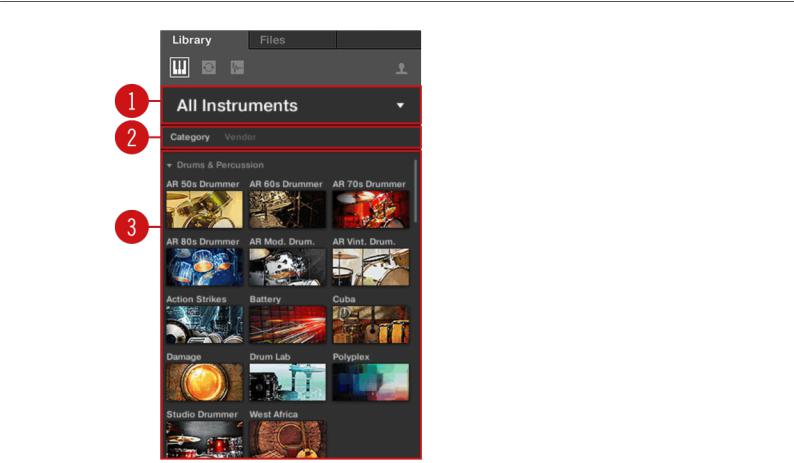
Software Overview
The Product selector.
(1) Product selector header: The header displays the selected Product. If there is no selection it shows a generic label (All Instruments or All Effects). A click on the header opens or closes the Product selector.
(2) Category / Vendor selector: Allows you to sort the Product list by Category or Vendor.
(3) Product list: Displays all Products that are available in your KOMPLETE KONTROL Library.
If Category is selected in the Category / Vendor selector, the Product list is sorted by the following categories:
•DRUMS & PERCUSSION
•SAMPLED INSTRUMENTS
•SYNTHESIZERS
•NO CATEGORY
If Vendor is selected in the Category / Vendor selector, the Product list is sorted by the names of the manufacturers.
For more information, refer to Filtering Preset Files by Product and Filtering Preset Files by Bank.
5.2.3. Files Pane
The Files pane contains following elements:
18
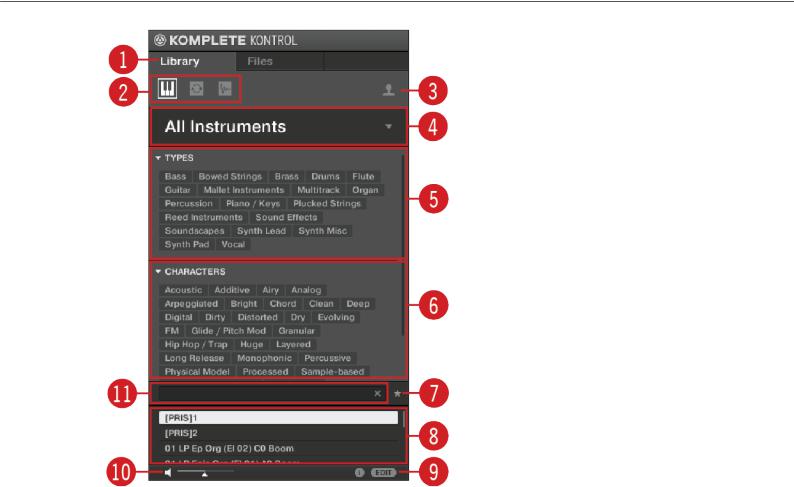
Software Overview
The Files pane in the Browser.
(1) Files: Displays the Files pane. For more information, refer to Working with the Files Pane.
(2) Favorite bar: Displays all your favorite folders. A click on any favorite folder lets you jump directly to that particular path and display its content in the Result list (5). For more information, refer to Working with File Location Favorites.
(3) Location bar: Displays the selected path. The Location bar provides various tools to quickly navigate your file system. For more information, refer to Navigating to File Locations with the Location Bar.
(4) Recent Locations button: Opens a list of the last visited locations for quickly jumping to any of them. For more information, refer to Navigating to Recent File Locations.
(5) Results list: Displays the content (files and folders) of the folder shown in the Location bar. Only files compatible with KOMPLETE KONTROL are displayed. For more information, refer to Additional Results List Features List in the Files Pane.
(6) Control bar: Provides useful tools when browsing your file system:
•The Information button (i) displays additional information about the selected files.
•The IMPORT button lets you import the content of the selected folder to the KOMPLETE KONTROL Library. Before any files are imported, you can choose which tags will be assigned to the files in the Attribute editor.
For more information, refer to Editing the Tags and Properties of User Preset Files and Importing KOMPLETE KONTROL-Compatible User Files.
19
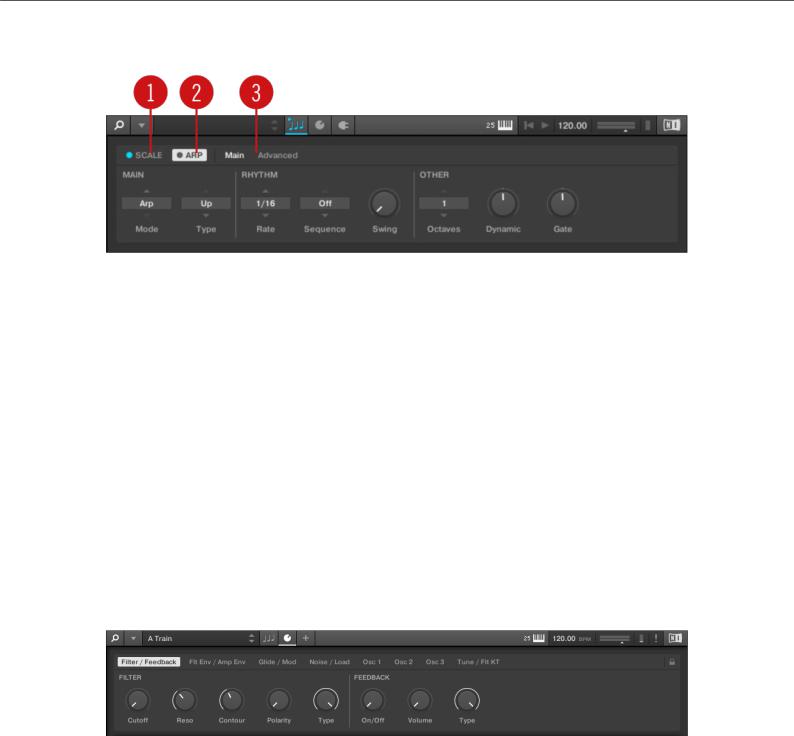
Software Overview
5.3. Perform Panel
The Perform panel.
(1) SCALE: Clicking the round button left of SCALE switches the Scale engine on or off. Clicking the SCALE label displays the Scale engine’s parameters. See Smart Play – Playing and Editing Scales and Chords for details.
(2) ARP: Clicking the round button left of ARP switches the Arpeggiator on or off. Clicking the ARP label displays the Arpeggiator’s parameters. See Smart Play – Playing and Editing Arpeggiator Sequences for details.
(3) Parameter pages: If multiple pages of parameters are available, you can switch between them here.
For more information, refer to Smart Play – Playing and Editing Scales and Chords.
5.4. Plug-in Panel
The Plug-in Panel lets you view and customize the parameters mapped to the Control section on the KOMPLETE KONTROL keyboard for individual Preset files. The amount of pages and parameters vary depending on the loaded Instrument or Effect.
The Plug-in panel.
For more information, refer to Customizing Parameter Mappings using the Plug-in Panel.
5.5. Plug-in Chain Panel
The Plug-in chain panel is situated at the top of the Plug-in area. The Plug-in chain is the place where you can directly load Instrument Plug-ins (Plug-in slot 1) and Effect Plug-ins (Plug-in slot 2 onwards) and arrange them in horizontal series. Each Plug-in is loaded into a Plug-in slot to create the Plug-in chain. The arrangement of the Plug-ins is customizable, but only an Instrument can be loaded in to the first Plug-in slot.
20

Software Overview
Overview of the Plug-in Chain panel.
(1) Plug-in chain: Displays the loaded Instrument and Effects.
(2) Plug-in slot: Each Plug-in slot represents a Plug-in and displays the Product’s name and image. Use the Plug-in slots to directly load Plug-ins, bypass Effects and customize the order.
For more information, refer to Working with Effects.
5.6. Plug-in Area
The Plug-in area of the KOMPLETE KONTROL software is where your Instruments, Loops, Oneshots and Effects are displayed once you have loaded them from the Browser. Each Product offers a different set of controls and parameters that are all easily controlled directly on the computer screen or from the keyboard. Parameter changes are mutually reflected by both the displays on the keyboard and the Instrument’s user interface in the Plug-in area.
For most Instruments, additional views are available that give you access to another set of controls. See Instrument Views for details.
21
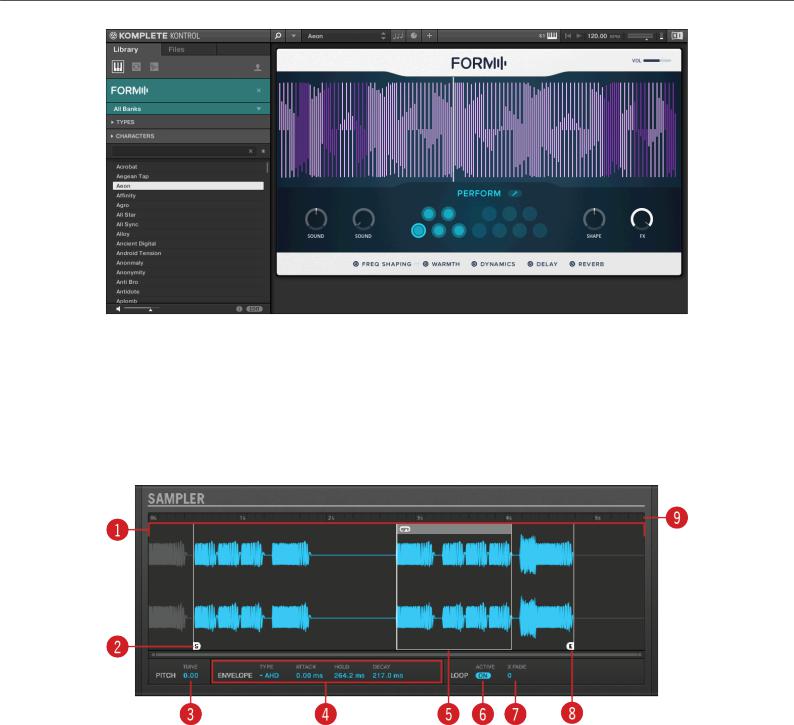
Software Overview
The Plug-in area displaying the Instrument Form.
5.7. Sampler
When loading a sample from the Loops and One-shots tab in the Browser, the sample will be automatically loaded into the Sampler so it can be played immediately. Important parameters can be accessed via the GUI, but all parameters for the Sampler can be accessed via the Plug-in Panel or a connected keyboard.
Sampler.
(1) Waveform display: Shows the waveform of the Sample.
(2) Start: Determines the Start point of the sample. When Loop is active, the Loop Point determines the start of the loop.
(3) PITCH: Defines the pitch of your sample and adjusts the pitch within three octaves up or down. As this is a traditional sampler.
(4) ENVELOPE: Selects one of three envelope types (One-shot, AHD and ADSR). For more information, refer to Envelopes.
(5) Loop Point: Sets the point at which the loop will start playing. The Loop Point can be set independently of the Start Point.
22
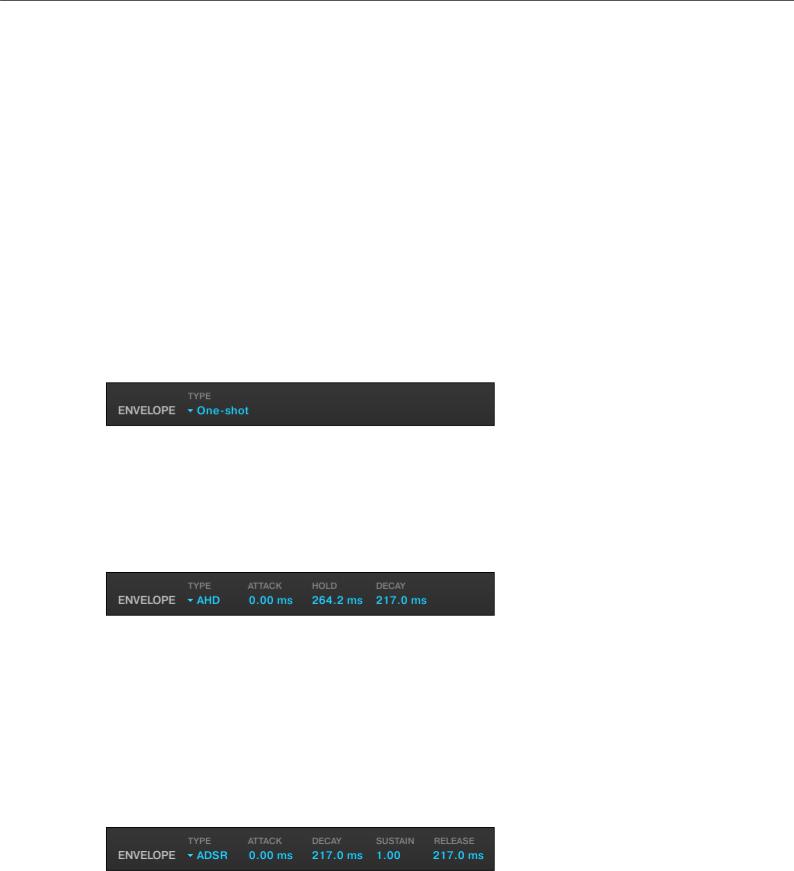
Software Overview
(6) LOOP: When the ON button is enabled, the sample will loop at a length determined by the Loop Point and End Point.
(7) X FADE: Determines the type of fade between the loop points.
(8) End Point: Sets the End point of the sample. When Loop is active, the End Point determines the length of the loop.
(9) Timeline: Shows the time scale in seconds.
5.7.1. Envelopes
An envelope allows you to modify the shape and timing of your sample, so you can create more expressive and dynamic sounds. There are three Envelope types available in the Sampler; One Shot, AHD and ADSR. Each Envelope will affect the playback and behavior of the sample.
One-shot
One-shot operates like a typical vintage drum machine; the sample is played in its entirety from beginning to end, with no envelope. When this type is selected, no parameters are displayed.
The One-shot Envelope.
AHD
AHD disables the Sustain and Release controls of the ADSR envelope and replaces them with the Hold parameter. AHD mode is ideal for triggering a sample for a certain amount of time, regardless of how long the pad is held.
The AHD Envelope.
ATTACK: Attack determines how quickly the sample reaches full volume after being triggered.
HOLD: Hold determines how long the envelope will stay at its maximum level.
DECAY: Decay is used to adjust how fast the sample takes to fade to out.
ADSR
The ADSR Envelope is generally used for longer, sustained samples that require complex dynamic control.
The ADSR Envelope.
ATTACK: Attack determines how quickly the sample reaches full volume after being triggered.
DECAY: Decay determines how fast the envelope drops to the Sustain level.
23

Software Overview
SUSTAIN: Sustain determines the constant level being kept after Decay until the note ends.
RELEASE: Release determines how long the sound takes to fade out after the note has ended.
24
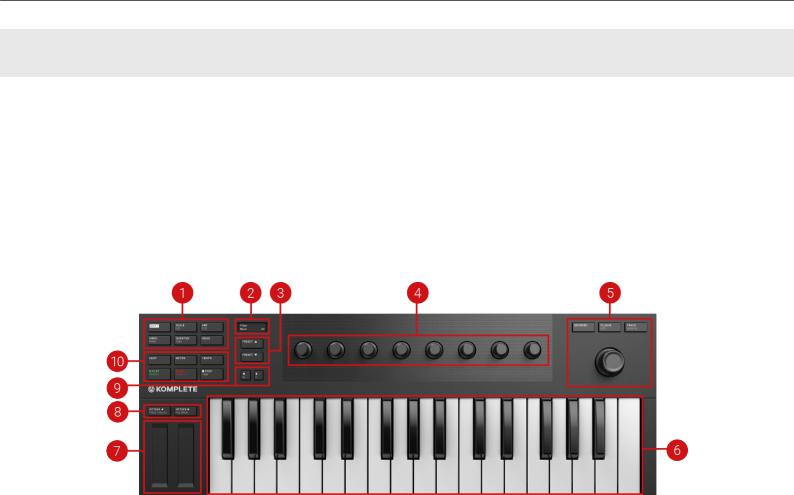
Keyboard Overview
6. KEYBOARD OVERVIEW
The KOMPLETE KONTROL keyboard is tightly integrated into the software and can be used to browse, control and play your Products as well as to control supported hosts.
The M32 keyboard is available in one size. It is equipped with a top-quality, semi-weighted keybed. Beyond the keybed, all keyboards come with identical features.
The keyboard is equipped with the following sections:
Top View
KOMPLETE KONTROL M32 top view.
(1) Perform and Edit section: Lets you edit and control the Smart Play features, e.g., playing scales, chords, and arpeggiator sequences. The settings made in the Perform and Edit section are reflected in the display (2). For more information, refer to Perform and Edit Section.
(2) Display: The two lines display provides you information about current context of, e.g., the Browser, the parameter assigned to a knob in the Control section, and the settings of the Perform and Edit section.
(3) Preset buttons: The PRESET up / down buttons let you skip to the next or previous Preset file of the loaded Product.
(4) Control section: The eight knobs dynamically adapt their assignment to the selected mode, allowing for direct access to the available parameters. As the knobs are touch-sensitive, you can tap them to see the current assignment in the display.
(5) Navigation and Mode buttons: Allows you to browse your KOMPLETE KONTROL Library and navigate in your DAW with the 4-D encoder, as well as switch between BROWSER and PLUG-IN mode. For more information, refer to Navigation and Mode Buttons.
(6) Keybed: Lets you play the loaded Instrument.
(7) Touch Strips: The Pitch Strip on the left allows you adjust the pitch of the loaded Instrument. The Modulation Strip on the right lets you adjust the default modulation parameter of the loaded Instrument. The Pitch Strip and the Modulation Strip are automatically assigned to corresponding controls of the loaded Instrument.
25
